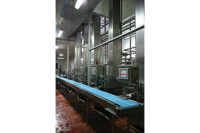Organic Valley taps wind energy, promotes waste reduction
One of Organic Valley’s goals from its founding has been to encourage a farming future emphasizing ecological and economic sustainability.
At the La Farge, Wis.-based farmer-owned cooperative, “the sustainability of our business depends on our owners passing on a healthy, productive farm to the next generation,” said Sustainability Program Manager Jonathan Reinbold.ne of Organic Valley’s goals from its founding has been to encourage a farming future emphasizing ecological and economic sustainability.
To that end the company has instituted a number of sustainable practices. Biodiesel has been used in fleet vehicles since 2002 and six years later Organic Valley began making its own biodiesel.
The cooperative has assisted its farmers with more than 20 renewable energy installations, including wind turbines, solar electric and solar hot water. Striving toward zero-waste, Organic Valley staff recycles and composts as much as possible. Last year, 95% of total waste was diverted from landfills. A van pool program for employees transports more than 50 staff members to work every day.
Last year, the Cashton Greens Wind Farm was placed into service in Cashton, Wis. In a partnership with Gundersen Health System, it is Wisconsin’s first community wind farm.
The two wind turbines are expected to each generate roughly 6 million kilowatt hours of electricity annually, enough electricity to offset about 600 homes per year per wind turbine. As co-developers and owners, Organic Valley and GHS fulfill the maintenance and financial roles normally reserved for utility or wind development companies. The two split the benefits of the wind-generated energy, which is enough to offset 68% of all of Organic Valley’s annual electricity needs at the time of project completion, Reinbold said.
“The venture is not about generating profit,” Reinbold said, “but about doing our part to produce cleaner energy, a cleaner environment and sustainable pricing for business and local municipalities. It’s about responsible business practice and community leadership.”
To share its efforts with others, the organic farmers’ cooperative this year published its first sustainability report specifically with consumers in mind (available on its website). This is in addition to the annual report it has produced for the Sustainable Food Trade Association since 2009.
Agri-Mark buys green energy at auction
For some time, dairy cooperative Agri-Mark, Methuen, Mass., has been actively exploring ways to integrate green energy into helping power its creamery operations. This December it takes a step in that direction when green energy will account for 10% of the electrical load at its West Springfield, Mass. facility.
To procure the green power, Agri-Mark teamed with World Energy Solutions, Worcester, Mass. Through the online auction platform, World Energy Exchange, the cooperative was able to test various terms and products in both green and brown energy markets in a “transparent manner and on an apples-to-apples basis,” said World Energy Solutions Director Tim Lockwood.
“Many companies believe the only way to purchase green power is directly through their utility or through a company that sells renewable energy certificates. That is not the case and is often not the best option available. We have found that ‘bundling’ green energy into our standard electricity auctions often nets a better result for the buyer,” he said.
Auctions are possible in deregulated markets, so for Agri-Mark that meant focusing on creameries in Upstate New York and Western Massachusetts.
“Other approaches are under consideration for our creameries in Vermont,” said Jed Davis, Agri-Mark’s director of sustainability.
Davis’ full-time position was created more than five years ago to focus specifically on sustainability matters.
“Whether talking about our solar-powered, Holstein-colored trash compactor or the newest version of our app, Reward Volunteers, we aspire to have sustainability as an integral part of our organization’s DNA,” Davis said.
Last year, Agri-Mark’s Cabot Creamery Cooperative was recognized as a Certified B Corporation. The designation is given to companies that meet rigorous, independent standards of social and environmental performance, accountability and transparency. The cooperative has a number of members involved in solar, wind and other forms of renewable energy. Davis highlights Foster Brothers Farm, where a digester was installed more than three decades ago, and Blue Spruce Farm, the 2012 recipient of a national Outstanding Dairy Farm Sustainability award from the Innovation Center for U.S. Dairy and the pilot farm for a successful Vermont utility program called “Cow Power.”
On-farm processing saves water, transportation fuel
When it comes to nature, the company’s goal is to protect and preserve the environment. “Dannon strives to reduce the impact of our operations throughout the life cycle of the foods we make,” said Michael Neuwirth, senior director of public relations.
In 2011, the company began a multi-year collaboration with McCarty Family Farms, Rexford, Kan. Under the agreement, the fourth-generation dairy farmers provide milk exclusively and directly to Dannon’s Fort Worth, Texas plant.
“Dannon began working with the McCartys in order to reduce the impact of the volatility of the price of milk and reduce the impact of the company’s environmental footprint and find ways to create a closer, more direct relationship between the farmer and the consumer,” said David Lainchbury, a Dannon vice president of sourcing and supplier development.
The first shipment of milk was delivered to the Texas dairy plant in April 2012. McCarty Family Farms also built an on-farm condensing plant that enables them to supply Dannon with condensed skim milk and pasteurized cream. In addition to reducing the environmental impact of shipping, it also allows the farm to reuse water retrieved during condensing. A complete carbon footprint analysis of McCarty Family Farms will provide a benchmark for progress.
This was just one project that helped Dannon reduce its carbon footprint in 2012 by 4.68%. In addition to sourcing milk from farms located as close as possible to its factories in Ohio, Oregon, Texas and Utah, the company has upgraded utility systems at all production plants, uses form-fill-seal packaging lines (to eliminate the transportation of empty cups) and uses trucking companies that participate in the Environmental Protection Agency’s SmartWay Transportation partnership to transport the majority (95%) of its products.
Though production increased, Michigan co-op reduced water use
he Michigan Milk Producers Association, Novi, Mich., has embarked on various initiatives — at the farm, corporate and plant level — to address consumers’ concerns regarding environmental sustainability and animal care.
“MMPA has always been mindful of the impact our processing plants may have on the environment and the communities we operate in,” said Clay Galarneau, MMPA general manager. “On the farmer side, members are extremely aware of the vast natural resources we have in Michigan, particularly fresh water, and adapt practices that preserve and protect the water and land around their farms.”
In 2010, a $62 million investment was made to MMPA’s Ovid, Mich. processing plant to modernize and expand facilities. Part of the project included a water recycling system. Well water consumption in 2010 was reduced by 18% while production increased by 24%. That same year, the plant was able to put 78 million more gallons of water back into the environment than it withdrew from wells.
Water retrieved during condensation (“cow water”) is used as a source for environmental sanitation, CIP and boiler make-up water, thus reducing the quantity of chemicals needed to de-mineralize and soften well water that the plant uses for cleaning.
“When we incorporated the extensive system to our Ovid plant, it not only reduced the amount of fresh water being used, it saved us costs and created a more efficient process for cleaning,” Galarneau explained, adding that member farms are encouraged to look to similar efforts.
“Reclaiming water from the bulk tank pre-cooler that can be used to wash the parlor or water cows saves natural resources and creates efficiencies.”
Glanbia Foods takes a shine to ‘polished water’
With water being a critical resource for the communities in which Glanbia Foods operates, Vice President Strategy Niamh Kelly noted that the Twin Falls, Idaho-based company is always looking at ways to reduce use of the natural resource.
Water was one of the 12 environmental areas in which the company set goals in 2010 and 2011. Electricity, natural gas and chemical usage were among the other dozen prioritized areas. When it came to water consumption, the two-year goal was for a 9.8% (5% per year) reduction. Glanbia more than doubled the goal, with a 26.6% reduction in water consumption across its four facilities. These include three in Idaho as well as the Southwest Cheese plant in Clovis, New Mexico.
“Glanbia facilities in Idaho reduced water consumption by 14% through engineering projects to increase polished water recovery and a reduction in the use of water as a heat exchange mechanism,” Kelly explained. “Polished water” is the water removed from milk through membrane systems and evaporators that is reclaimed for cleaning and other plant-related processes. Using the polished water allows for a significant reduction in the volume of clean water (from wells or purchased from the city) needed for processing at the facility.
Polished water was also increased at the Southwest Cheese plant and design changes were implemented to eliminate inefficiencies. Cleaning practices were refined and the processor implemented daily loss-focused reviews. All led to a 49% reduction in water consumption.
All of Glanbia’s facilities have obtained the highest level of food safety certification, Safe Quality Foods Level 3.
The 2012-2013 goals for Idaho include reducing water usage by 3% annually; while the Southwest Cheese plant has a goal of maintaining the almost 50% reduction it has already achieved.







